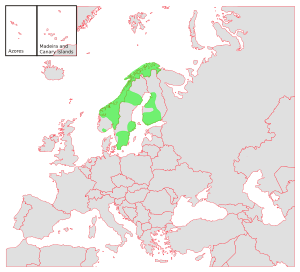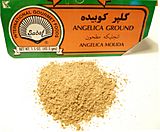Persian hogweed facts for kids
Quick facts for kids Persian hogweed |
|
|---|---|
 |
|
| Flower and leaf | |
| Scientific classification | |
| Genus: |
Heracleum
|
| Species: |
persicum
|
Heracleum persicum, often called Persian hogweed or by its native name Golpar (Persian: گلپر), is a tall plant. It belongs to the carrot family, Apiaceae. This plant grows wild in humid, mountainous areas of Iran and nearby regions.
It was brought to Scandinavia in the 1830s. Since then, it has spread widely. In northern Norway, it is very common. People there sometimes call it the Tromsø palm. The plant has also been seen in Sweden. In Finland, it is considered an invasive species. This means it can harm local plants and ecosystems.
Persian hogweed is a polycarpic perennial plant. This means it lives for many years. It flowers and produces fruit season after season.
Contents
Why Is Persian Hogweed Invasive?
Since 2016, Persian hogweed has been on a special list in Europe. This list is for "Invasive Alien Species of Union concern." This means the plant can cause problems for local environments.
Because it is on this list, it cannot be brought into the European Union. People also cannot grow it, move it, or sell it there. It is also not allowed to be planted or released into nature on purpose. These rules help protect native plants and animals.
How Is Persian Hogweed Used?
Food Uses
The seeds of Persian hogweed are used as a spice in Persian cooking. These very small, thin seeds are called mericarps. They have a nice smell and a slightly bitter taste. They are usually sold as a powder. Sometimes, they are mistakenly sold as "angelica seeds."
The powder is often sprinkled over broad beans, lentils, and other legumes. It is also used on potatoes. Golpar is a common ingredient in soups and stews. It is often sprinkled over pomegranate seeds. Sometimes, golpar is mixed with vinegar. Broad beans are then dipped into this mixture before eating.
Golpar can be used in small amounts when cooking beans. For example, one or two teaspoons per pound of beans. Some people believe it helps reduce the gassy feeling that can come from eating beans.
In Persian cuisine, the petals of the plant are used in a spice mix called advieh. This mix flavors rice dishes. It is also used in chicken, fish, and bean meals.
The soft leaves and leaf stalks can also be pickled. This pickled version is known as golpar torshi.
Controlling Persian Hogweed
Controlling the spread of Tromsø palm, another name for Persian hogweed, is important. One way to fight it is by constantly cutting down new shoots. When cutting the plant, it is a good idea to wear protective gear. This is because the plant's juice can cause irritation. Metal cutting tools should also be cleaned after use. This helps prevent the juice from causing damage to the tools.
See also
 In Spanish: Heracleum persicum para niños
In Spanish: Heracleum persicum para niños



